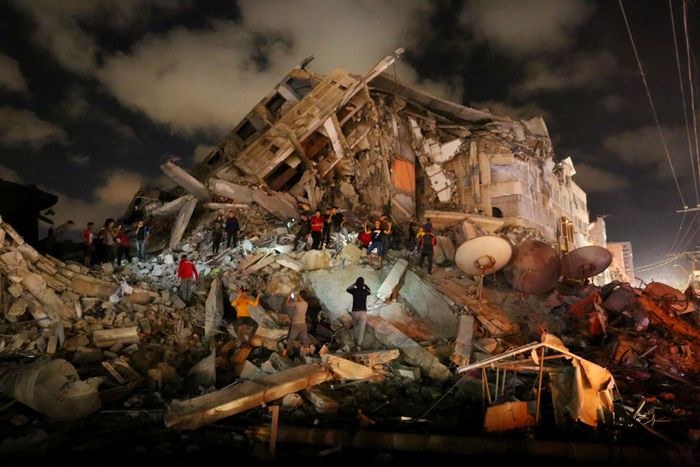
Joe Biden wouldn’t put it this way, but for nearly four months he was lucky. Yes, he had to confront a once-in-a-lifetime pandemic, a crumbling democracy, a stalled economy, and a cascade of attendant crises. But he seemed to be handling the load in surprisingly deft fashion — which is what made the intrusion of the first foreign calamity of his administration especially jarring. The violence between Israel and Hamas that has left hundreds of people in Gaza and a dozen in Israel dead has tested Biden’s style of governance (deliberate, commit unswervingly to a plan, deliberate some more) in ways that the domestic horror show has not.
The Biden administration’s first round of public responses to the conflict felt awkwardly out of sync. The president, whose perceptions of Israel were first shaped in the 1970s, started off in step with decades of Democratic (even bipartisan) dogma, reaffirming Israel’s right to self-defense. But the first sign that this round of fighting wouldn’t play out like previous ones — that something essential was shifting in American attitudes about the Middle East — came when some of Biden’s senior officials expressed discomfort with the intensity of Israel’s military actions. After Israel destroyed a building in Gaza that housed the offices of the Associated Press and Al Jazeera, saying that Hamas was operating there, Secretary of State Antony Blinken pointedly noted he had yet to see any support for the claim. It wasn’t a chasm, but if there’s one area in which you can expect message discipline from a presidential administration, it’s on matters of Israel in the midst of violence. Meanwhile, the U.S. position on a cease-fire was garbled: Biden implied support for it without expressly demanding as much, even as his representative at the U.N. was blocking the Security Council’s repeated calls for one.
One easy method for explaining away a muddle is to insist, as Biden’s team did, that the real work was all happening behind the scenes — that they were giving Israel space to maneuver toward peace. But while it’s true that Biden, Blinken, and national security adviser Jake Sullivan were working the phones, and a State Department envoy had touched down in the region, the president had no delusions of bringing a grand Pax Bidenica to the Middle East. Since he first came to Washington, he has seen nine presidents take on the Israeli-Palestinian conflict and come up short. For now, he just wanted an end to the fighting.
For all the talk of an FDR presidency, on the world stage a Biden doctrine has yet to solidify. Left-wing sympathies have been drifting away from Israel for years, so it was not unexpected for the administration to get pressure from Democrats like Bernie Sanders (who took to the New York Times to urge a reevaluation of the billions America gives the country in aid) and Alexandria Ocasio-Cortez (who tried to block a new round of arms sales). But there was no hiding the White House’s surprise when more mainstream Democrats stepped in — particularly when New Jersey senator Robert Menendez, a longtime Israel ally and the chairman of the Foreign Relations Committee, said he was “deeply troubled” by the death of civilians at the hands of the Israeli military and its targeting of the AP building. Jon Ossoff, a freshman senator, led a surprisingly popular call for a cease-fire.
The left’s shift on Israel has hardly come out of nowhere. “Why Democrats are more vocally critical of Israel today is because Israeli politics has moved and the Republican Party has moved,” Chris Murphy of Connecticut, who runs the Senate subcommittee covering the Middle East, told me. For a decade, Prime Minister Benjamin Netanyahu has veered to the right, courting conservatives in the U.S. Breaching protocol, he all but endorsed Mitt Romney in 2012, then fought Barack Obama’s Iran nuclear deal. During Donald Trump’s term, he was especially close to Jared Kushner. But if Biden has used a marginally harsher tone with Netanyahu, it has been deployed incrementally, in line with the mounting death toll. When the two first spoke about the violence on May 12, the White House said the president “conveyed his unwavering support for Israel’s security and for Israel’s legitimate right to defend itself and its people, while protecting civilians.” When they talked three days later, the White House PR shop reiterated that but noted Biden’s concern “that this current period of conflict has tragically claimed the lives of Israeli and Palestinian civilians, including children.” By May 17, after 28 Democratic senators joined Ossoff’s statement, Biden “expressed his support for a cease-fire” to Netanyahu — and the White House made sure to leak to the Times that Biden had used even sterner words in private.
To some left-wing Democrats, this was still inadequate, proof that Biden is afraid to truly criticize Israel. But Biden didn’t want to urge a cease-fire only for Netanyahu to ignore or actively defy him. (That’s what happened during the 2014 strife, when then–Secretary of State John Kerry traveled to the area.) It’s also clear that he sees much less upside than some of his fellow Democrats do in publicly rebuking such a close ally. “The way to deal with the Israelis is to be supportive,” one Democrat engaged with the White House’s negotiations told me. “And to apply pressure quietly.”
This isn’t exactly the presidency Biden dreamed about for most of his half-century in D.C. For years, he mused about how the Oval Office often had less sway over domestic politics than most people believe and how the job’s primary influence was as commander-in-chief. As he thought about what he would do in office, he spoke often of using Air Force One and his conviction that foreign policy is an “extension of personal relationships,” but with higher stakes.
That theory of personalized foreign affairs is now undergoing an uncomfortable challenge. Biden and Netanyahu have known each other since the early 1980s, when one was a new senator and the other an official in Israel’s D.C. embassy. People close to Biden believe he has as strong a relationship with Netanyahu as any prominent Democrat at this point, but, increasingly, that’s a low bar. And so far, any understanding between the men has yielded precious little in public.
Biden’s short-term solution was to try to create headlines elsewhere while his diplomats worked in private. On Tuesday, he flew to Michigan to drive Ford’s new electric pickup truck as part of the pitch for a $2 trillion infrastructure proposal. As he landed in Detroit, however, he was greeted by Representative Rashida Tlaib, a daughter of Palestinian immigrants who still has family in the West Bank. Before Biden could get in his car to go to Dearborn, whose population is heavily Arab American, she insisted to him that Palestinian human rights could not be ignored. Biden acknowledged Tlaib during his speech and said he was praying for her family, but otherwise kept his focus on cars and infrastructure.
Soon, Biden, wearing aviators, was behind the wheel of the F-150 Lightning on a Ford test track. “This sucker’s quick,” he said. “Mr. President,” a reporter said, “can I ask you a quick question on Israel before you drive away, since it’s so important?”
“No, you can’t,” Biden said. “Not unless you get in front of the car as I step on it. I’m only teasing!” Then he peeled out.
Back in Washington the next morning, the White House revealed that he had spoken to Netanyahu yet again, this time adopting a harder line, conveying “that he expected a significant de-escalation today on the path to a cease-fire.” Netanyahu evidently didn’t think much of it. Before the morning was out on the East Coast, he would say he was “determined to continue this operation until its aim is met.” The violence spread: Four rockets were fired into Israel from Lebanon, and the Israeli military replied in kind. It took another day of U.S. pressure, and the assistance of the Egyptians, before Israel and Hamas agreed to a truce. No one could be sure how long it would last.






























